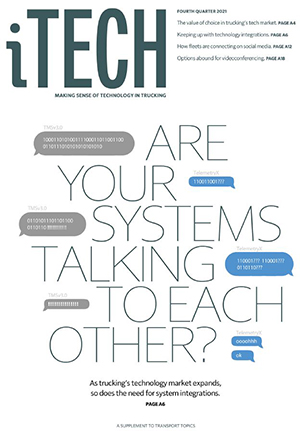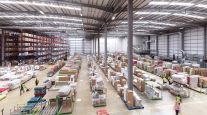Managing Editor, Features and Multimedia
The Value of Choice
[Stay on top of transportation news: Get TTNews in your inbox.]
For decades, the steady advance of information technology has continuously improved the way trucking and logistics companies manage their businesses. With each passing year, the trucking industry’s technology market expands with more products and services designed to give fleet managers, dispatchers and drivers access to more information so they can make better decisions and unlock further gains in safety and efficiency.
As a result, freight transportation companies looking to improve their operations through technology adoption have never had so many options as they do today.
Transportation management software is evolving to incorporate more business-process automation, increasingly sophisticated data analytics, cloud computing and machine learning.
Fleet telematics, which began with basic vehicle tracking and in-cab communication, has blossomed into a prime example of the Internet of Things. Modern trucks and trailers can be equipped with sensors to remotely monitor everything from tire pressure to cargo status.

Clevenger
Onboard video, once a niche product category, has become commonplace in trucking as more motor carriers deploy products ranging from simple dash cameras full-fledged video telematics systems.
The federal electronic logging device mandate, which went into effect in late 2017, drove widespread adoption of in-cab technology to automate hours-of-service compliance. The regulation attracted a wave of tech startups to the industry, with many of those companies targeting the small carrier market.
At the same time, truck drivers are increasingly using mobile apps on their personal devices or company-provided systems to manage their work flows more efficiently.
More Q4 iTECH Stories
►The Need for Seamless Connections Between Disparate Systems
►Using Social Media to Connect With Drivers, Customers
►Dysart: Key Features of Videoconferencing for Trucking Firms
►Isaac, Trimble Among the First to Receive ELD Certification in Canada
And shippers and third-party logistics providers are utilizing freight visibility software to better manage their supply chains.
This proliferation of freight technology is apparent at industry trade shows, where technology providers often occupy as much exhibit hall space as trucks, trailers, engines and tires.
It can be a daunting task for fleets and logistics firms to sift through the vast menu of potential technology investments available today, but ultimately this wealth of options serves the industry well.
Trucking remains a highly fragmented industry with diverse applications and operating conditions, so one size does not fit all when it comes to technology adoption.
It’s true that different trucking companies comply with many of the same regulations, travel on the same highways and deal with common challenges such as driver recruiting and retention, the scarcity of truck parking and a constant focus on safety, to name a few.
Nonetheless, individual companies each have their own unique challenges and concerns. They haul different types of freight with different types of equipment. Applications range from longhaul to regional, shorthaul and local delivery. Companies also must meet the unique demands of their specific shipper customers.

Big rig braking is an engineering marvel. Host Michael Freeze finds out more about the advanced technology that halts 18-wheelers, no matter the weight, instantaneously. Hear a snippet above, and get the full program by going to RoadSigns.TTNews.com.
Naturally, the right technology choices for a trucking company depend in large part on all of those variables.
To optimize their operations, fleets are assembling a mix of back-office software applications and in-cab technologies that best fits their businesses. In doing so, they are often implementing an increasing number of separate systems from multiple vendors, and in some cases developing their own, in-house technology.
That’s why integrations between different technology vendors are so essential in today’s marketplace. Fleets can only build their preferred technology ecosystem if the individual products and applications they select can fit together seamlessly.
For technology vendors, that can mean developing integrations with dozens — if not hundreds — of other systems. It also may involve working with companies that are direct competitors in some product categories in order to support their joint customers.
As trucking’s technology market continues to expand, that type of collaboration across company lines will only become more important.
In the end, it all boils down to customer service. The most successful technology vendors have been — and will continue to be — the ones that remain laser focused on meeting their customers’ needs, even if that involves maintaining a complex web of integration partnerships.
Want more news? Listen to today's daily briefing below or go here for more info:





